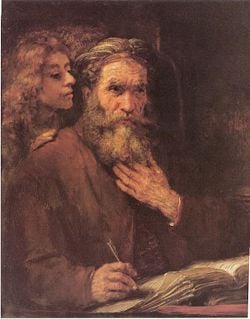Saint Matthew
| Saint Matthew | |
|---|---|
Saint Matthew and the Angel by Rembrandt | |
| Apostle, Evangelist, Martyr | |
| Died | 24 January in near Hierapolis or Ethiopia |
| Venerated in | Roman Catholic Church Eastern Orthodox Churches Eastern Catholic Churches Anglican Communion Lutheran Church some other Protestant Churches |
| Canonized | pre-congregation |
| Major shrine | Salerno, Italy |
| Feast | 21 September (Western Christianity) 16 November (Eastern Christianity]] |
| Attributes | tax collector |
| Patronage | Accountants, Salerno, Italy, and others, see[1] |
Matthew the Evangelist (מתי/מתתיהו, "Gift of Yahweh," Standard Hebrew and Tiberian Hebrew: Mattay or Mattithyahu; Septuagint Greek: Ματθαίος, Matthaios, Modern Greek: Ματθαίος [Matthaíos]), most often called Saint Matthew, is a Christian figure, and one of Jesus's Twelve Apostles. He is credited by tradition with writing the Gospel of Matthew, and is identified in that gospel as being the same person as Levi the publican (tax collector).
Identity
Matthew the Evangelist is complex for a number of reasons. The gospel to bear the name "Matthew" was written anonymously, with tradition ascribing authorship to Matthew at a later date. Both the style of Greek used and the means of describing events lead some to conclude that the author of the gospel was not a companion of the historic Jesus. Some use the designation "Matthew the Evangelist" to refer to the anonymous gospel author, and "Matthew the Apostle" to refer to the Biblical figure described. Christian tradition holds that they are the same person.[citation needed]
Matthew's depiction in the New Testament is likewise complex. In the gospels of Mark and Luke, as well as in the Acts of the Apostles, Matthew is mentioned without any title, identifier, descriptions, or actions. Virtually nothing besides his apostleship can be determined from these accounts, and he is not mentioned at all in the Gospel of John or subsequent epistles.
The Gospel of Matthew, on the other hand, names Matthew as the publican called by Jesus, whom the other gospels name "Levi." This gospel subsequently gives Matthew the title "the tax collector" in its list of the Twelve Apostles. Christian tradition holds that Matthew and Levi were, in fact, two names for the same person (similarly, tradition posits a "Jude Thaddeus" to reconcile the Jude of Luke and Acts with the Thaddeus of Matthew and Mark.) Modern Biblical scholarship holds this position as highly unlikely, however.[2] If one concludes that the Gospel of Matthew's stories of St. Matthew are based on Mark's stories of Levi, a different person, then one can say nothing about Matthew the Apostle besides the fact that he was one of the Twelve.
However, the Catholic Encyclopedia asserts that Matthew once could have been called "Levi," according to Mark 2:14. The Encyclopedia also states that "The fact of one man having two names is of frequent occurrence among the Jews."[3] Other gospel passages that refer to Matthew or Levi are Mark 2:1-22 and Luke 5:27-39.
Levi is described in Mark (and synoptic parallels) as being a tax collector who was called by Jesus to follow him just as the Twelve Apostles were. He is called the "Son of Alphaeus," and his calling leads into a scene where Jesus is confronted by Pharisees for eating with tax-collectors and sinners. It is possible that James, son of Alphaeus, had been distinguished from James, son of Zebedee by the former's other name "Levi" and that James, son of Alphaeus was called to the Apostolate along with Luke.
bronze by Lorenzo Maitani and his collaborators, Orvieto Cathedral, Italy
Commemoration
Matthew is recognized as a Saint in the Roman Catholic, Eastern Orthodox, Lutheran and Anglican churches. His feast day is celebrated on 21 September in the West, 16 November in the East (for those churches which follow the traditional Julian Calendar, 16 November currently falls on 29 November of the modern Gregorian Calendar). He is also commemorated by the Orthodox, together with the other Apostles, on 30 June (13 July), the Synaxis of the Holy Apostles.
Like the other evangelists, Matthew is often depicted in Christian art with one of the four living creatures of Revelation 4:7. The one that accompanies him is in the form of a winged man. The three paintings of Matthew by Caravaggio in the church of San Luigi dei Francesi in Rome, where he is depicted as called by Christ from his profession as tax gatherer, are among the landmarks of Western art.
See also
| Saints Portal |
- Gospel of Matthew
- Mark the Evangelist
- Luke the Evangelist
- John the Evangelist
Life of Jesus: Ministry Events | ||
Hometown Rejection of Jesus, "Physician, heal thyself" |
Events |
New Wine into Old Wineskins |
Notes
- ↑ http://www.catholic-forum.com/SAINTS/saintm13.htm
- ↑ Anchor Bible Reference Library, 2001. p.130-133, 201
- ↑ Jacquier, E. St. Matthew, 1911 The Catholic Encyclopedia, New York: Robert Appleton Company, [1]
ReferencesISBN links support NWE through referral fees
External links
- St Matthew the Apostle from The Golden Legend
- Apostle and Evangelist Matthew Orthodox icon and synaxarion
- Synaxis of the Holy Apostles
| |||||
| |||||||||||||||||||||||||||||||||||
Credits
New World Encyclopedia writers and editors rewrote and completed the Wikipedia article in accordance with New World Encyclopedia standards. This article abides by terms of the Creative Commons CC-by-sa 3.0 License (CC-by-sa), which may be used and disseminated with proper attribution. Credit is due under the terms of this license that can reference both the New World Encyclopedia contributors and the selfless volunteer contributors of the Wikimedia Foundation. To cite this article click here for a list of acceptable citing formats.The history of earlier contributions by wikipedians is accessible to researchers here:
The history of this article since it was imported to New World Encyclopedia:
Note: Some restrictions may apply to use of individual images which are separately licensed.
